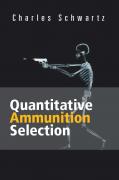Actually, you could, but you would need the correctly fitted "alpha" exponent to do so. If projectile expansion/deformation were uniform, it might be possible to use the exponent (which acts much like a drag coefficient in the mTHOR power law) for an expanded JHP, but for a projectile whose expansion profile differs greatly from an expanded JHP, a new/different exponent would certainly be required. The same can be done with the Q-model with an equal proviso for using a new/different/correct CD if/where required.
To amplify further upon the point that you have made here—
Both equations (the "Q-model" and the "mTHOR model")—and MacPherson's equation—can be used to predict the maximum terminal penetration of non-expanding projectiles without testing, but testing is ALWAYS highly recommended. While non-expanding designs typically do not expand in water or 10% gelatin, that possibility does exist, and they should be tested at some point to confirm their actual behavior in either test medium.
All three models ("Q", "mTHOR", and MacPherson) can be used as heuristic tools bearing in mind that their respective predictions are just that—they are predictions!
The predictions made by all three mathematical bullet penetration models also rely upon certain assumptions/presumptions:
1. that the projectile maintains a 'nose-forward attitude' throughout the entirety of the penetration event being modeled
2. that expansion of the projectile—if it occurs—is uniform and consistent
3. that the projectile does not disintegrate or fragment completely and,
4. that the projectiles and test mediums are all perfectly isotropic
In reality, neither projectiles nor test mediums are perfectly isotropic in their respective construction. Microscopic variations in the materials composing the projectile and minimal fluctuations in individual projectiles arising from varying tolerances the manufacturing process—which does not produce perfectly identical projectiles in the first place—in addition to the imperfect isotropic nature of valid test mediums, contributes to the variations in terminal expansion and penetration depths observed when any given projectile construction is actually tested in gelatin or water test mediums.
Since you have brought it up here—
—I'll clarify my thoughts (simply because no one has mentioned it until now) regarding the use of these bullet penetration models to make predictions for multiple projectiles striking a target simultaneously...
None of the simple mathematical bullet penetration equations presently under discussion here (namely, the "Q", "mTHOR", and MacPherson models) are really capable of accurately modeling the behavior of multiple projectiles in simultaneous penetration events. Multiple projectiles striking a target simultaneously create enormously complicated challenges (temporary and permanent cavities that may or may not intersect wholly or partially—theorized as 'drafting' in earlier posts by pettypace, non-uniform expansion, etc.) that these mathematical bullet penetration models simply cannot account for. Complex multi-projectile modeling can be accomplished through the use of multi-physics FEM suites like ANSYS and LS-DYNA, but those options are far beyond the grasp and processor-power of "ordinary, average guys" (like us) wishing to investigate the potential terminal performance of multiple projectile loads. Such theorizing is certainly one of the more attractive utilities of eloquent equations like the "Q", "mTHOR", and MacPherson models because running FEM computations ''by hand'' on a scientific calculator would literally take months (or even years!) to complete for just one prediction. Ultimately, as I have said before, testing in a valid medium* is ALWAYS highly recommended.
Short of using FEM software, these simple equations are the best that we have.
*My opinion of the Clear Ballistics Gel product, and all other ''as-yet unproven synthetic test mediums'', is clear and well-known (at least here anyway), so I'll not waste further bandwidth restating it here.





 Reply With Quote
Reply With Quote
